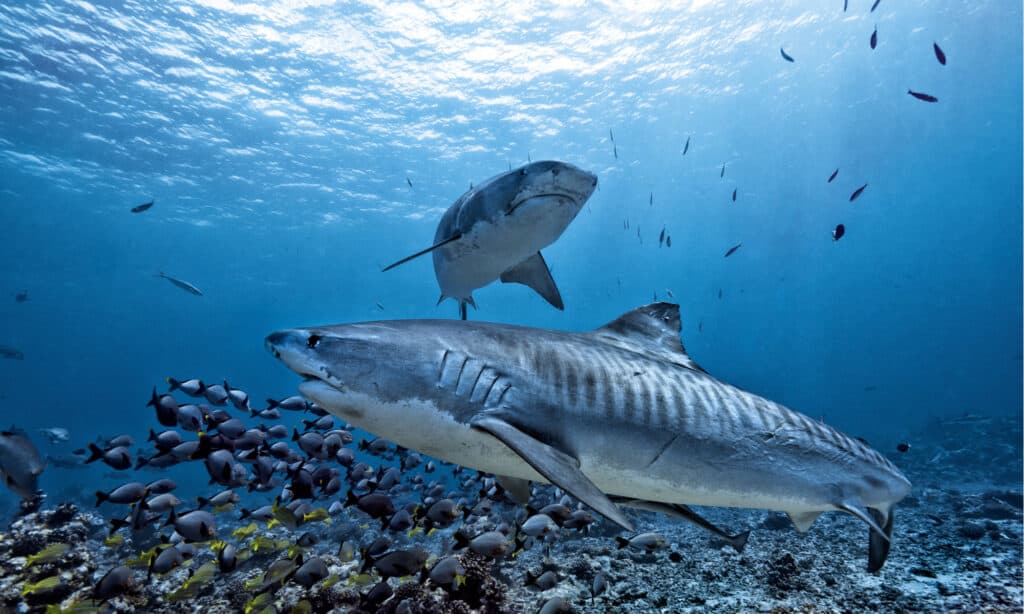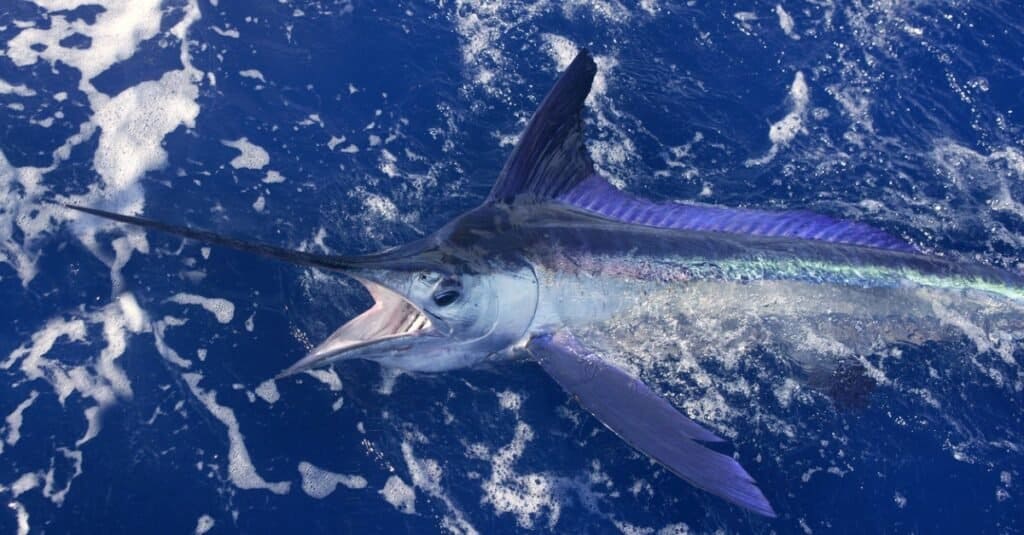Continue reading for our analysis...

Marlin is one of the largest and fastest fish you can find in the ocean. They are easily recognized by their blade-like upper jaw, which they use to slice through fish, making them a lot easier to catch. Due to their rarity, size, and power, the marlin is considered to be the peak of game fishing.
Tiger sharks are known to be solitary hunters, with a reputation as the ocean’s garbage can, consuming almost anything they see. Their unique teeth are developed to slice through flesh and bone, as well as tough substances like turtle shells.
In this video, four men are out fishing off Cairns, Australia, ready to pull up a large marlin catch. There’s no lead-up to the moment—when the video starts, the men are already exclaiming.
“Sharks got him! Bring it up guys,” yells the cameraman from the top of the boat as he looks down at the scene. “You’re kidding!” says the man below, bewildered.
From his vantage point, the cameraman says “Yeah, I can see all the blood.”

The tiger shark is known for its voracious appetite and razor-sharp teeth capable of cutting through even a turtle’s shell
©iStock.com/Divepic
The angler is seated securely on the deck of the boat, his feet up against a base for leverage as he keeps striking to pull in the massive fish. All three men look out expectantly, waiting to see what comes out of the water.
Suddenly, the marlin is spotted—but as the cameraman warned, it is not alone. Tiger sharks and bronze whalers have decided this meal is for them, and they leap out of the water, biting chunks off of the fishermen’s catch.
Commotion in the water continues as one of the men on the deck reaches out to grab the fishing line with a gloved hand. The men continue attempting to pull the marlin up as the cameraman reminds them to be careful.

Tiger shark teeth have a cutting and sawing region.
©Matt9122/Shutterstock.com
“Get the cutters!” he yells as the line can be seen pulling downward toward the side of the boat. The camera then captures the moments as the man rushes down to the deck (if you get easily dizzy, you may want to look away for a few seconds until the camera stops moving about wildly).
“You got his head?” the cameraman asks.
One of the men reaches down, grabs the line close to the marlin’s head, and pulls it on board.
“This is like a 600-pound fish,” he says, as he holds it from its upper, pointed jaw.
One of the men shakes hands with the angler, congratulating him on a job well done. There is a noticeable air of disappointment swirling about the boat from all men as they process the loss of the day.
“Don’t get in the water now, boys,” one of the men says, adding a bit of humor to the moment, as they
look out onto the water.
Is it Normal For Sharks To Eat Marlin?

Tiger sharks are among the large shark species that consume adult marlins.
©le bouil baptiste/Shutterstock.com
The simple answer here is, yes. The sheer size of marlin fish makes it difficult for any other ocean mammal to hunt. The size of marlin predators increases in size as their size increases. That means that the adult blue marlin is only eaten by other large open ocean shark species including tiger sharks.
While large sharks such as tiger sharks consume marlin, other sharks seem to prefer other prey. Hammerhead sharks eat all of the stringrays they can get – while blue sharks seem to like squid.
Habitat

Marlins are among the fastest marine swimmers, reaching ~110 km/h (68 mph) in short bursts.
©iStock.com/LUNAMARINA
The blue marlin and the tiger shark can be found in tropical and subtropical waters, which include the Atlantic, Pacific, and Indian Oceans. These fish both prefer the warmer currents, migrating during the colder seasons to stay closer to warmer waters.
Is Australia Or The U.S. The Most Shark Infected?
Of the more than 400 species of sharks found worldwide today, around 170 are found in Australian seas. Australia is home to the most diverse shark population yet they are in second place for shark attacks – behind the United States!
In 2021, the United States recorded the most unprovoked shark bites with 47 confirmed cases. Australia recorded 11. Although the number of attacks went down in 2022, the United States still leads the world with the highest amount of unprovoked cases at 41 and Australia dropped to 9.
Other Amazing Animal Videos You Might Like
A crocodile swims in the grey-blue ocean close to giant dark rocks. But it isn’t alone. There in the water, a slightly smaller, but no less sinister shadow can be seen trailing the reptile. It is a shark and it’s probably wondering if this large scaly intruder would make a tasty meal. Find out how it all unfolds.
Thank you for reading! Have some feedback for us? Contact the AZ Animals editorial team.







